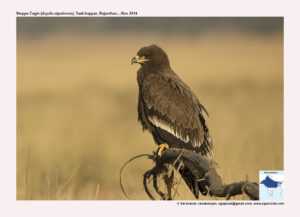Steppe Eagle

Steppe Eagle Aquila nipalensis
Etymology:
- Aquila : Latin word aquilus – Dark coloured
- Nipalensis : From Nepal
Vernacular Names: Mar: Nepali Garud
Distribution in India: Wide spread winter visitor to North, West and Central India.
Description: Size of 76-80 cm; Wt. of male is 2000–3500 g, Wt. of female is 2300–4900 g; wingspan of 165–214 cm.It has long and broad wings with more pronounced and spread fingers and a protruding head and neck. Wings are flat when soaring and angled down slightly at carpals when gliding. When perched appears big and heavy with heavy baggy trousers. Adults have an underwing pattern of dark trailing edges with distinct barring on remiges and non-existent pale crescent at carpal region. It has a rufous nape patch and a pale chin. The gape extends well beyond the eye. The Juvenile has a broad white bar across the underwing and a white crescent across the upper tail coverts.
Habitat: It is found in open habitats such as steppe and semi-desert shrub lands and grasslands.
Food Habits: It eats medium-sized mammals, birds, reptiles and insects. Also eats carrion during migration and in winter. Forages mainly by soaring at 150–200 m height and diving down; also ambushes prey, by waiting at burrow entrance, and takes some prey while walking on ground.
Breeding Habits: They breed in Apr- July in Romania east through the south Russian and Central Asian steppes to Mongolia. The nest is a large platform of sticks but variable in size depending on availability of nest material; nest cup often lined with smaller twigs and many other material, like old rags, bones, moulted feathers and camel dung. Nest usually built on ground in position that allows good view of surroundings. It lays a clutch of 1–3 eggs. The incubation period is 45 days. The chicks are born altricial and the fledging period is 55–65 days.